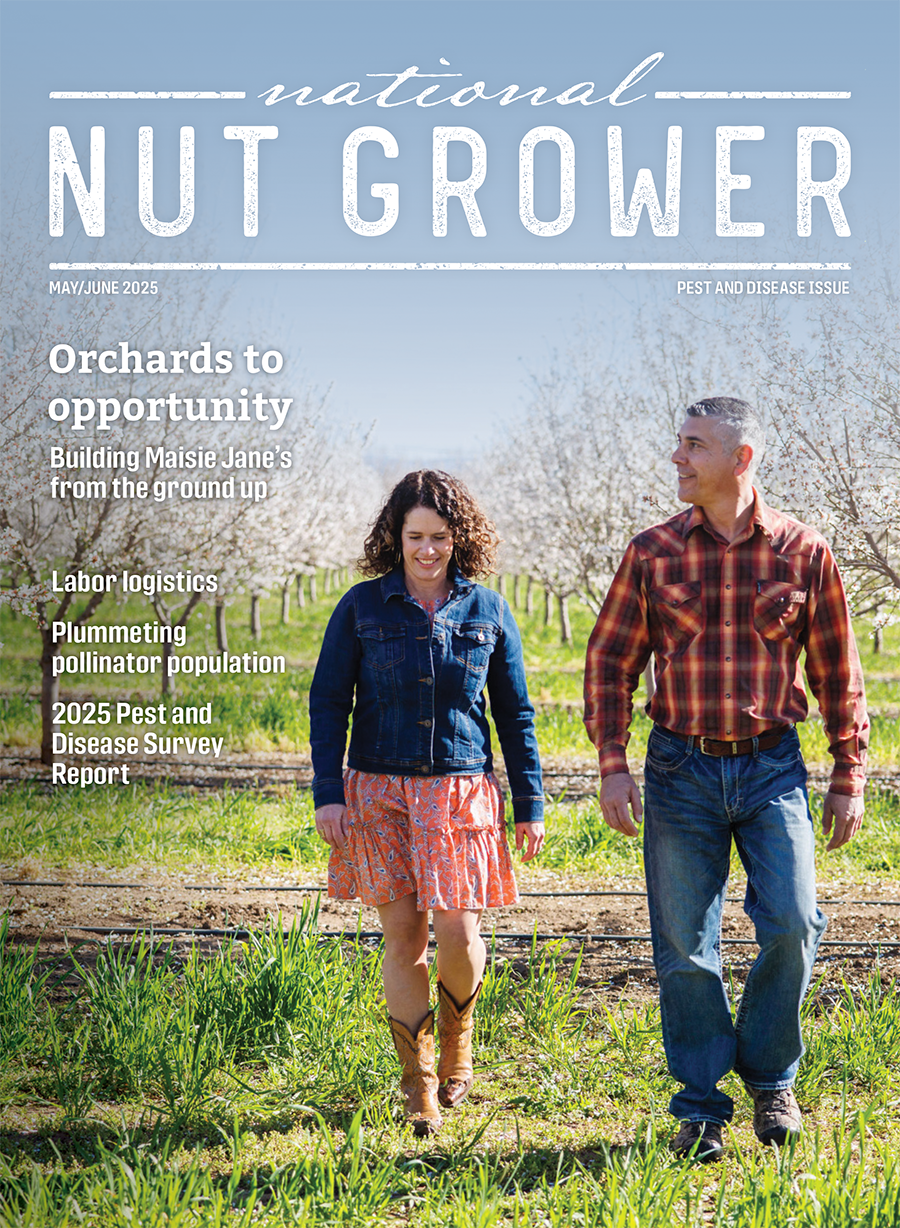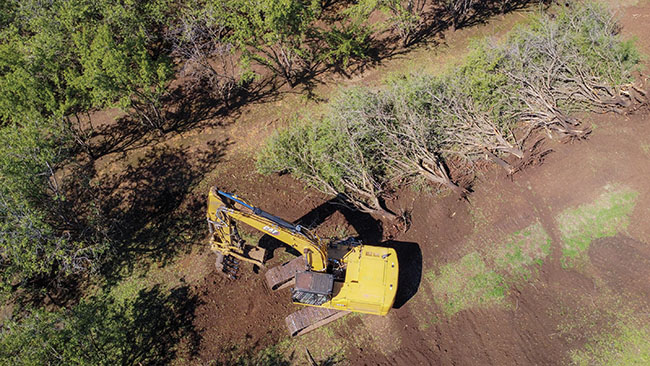
Nov/Dec 2022
All-in on climate-smart
NicNut Farms, formerly known as Nicolaus Nut, is going all-in with climate-smart practices on the mid-sized farm just south of Chico, California. While this almond and walnut farm is part of a lineage of six generations of farmers, it’s also paving the way for a new type of farming at a time when growers are at the crux of the farm of the future.
George Nicolaus, owner of NicNut, moved out to California from the Midwest and planted walnuts in the late 1980s, and has farmed anywhere from about 150 acres to 800 acres at any given time. Currently, the farm is under 300 acres, and has hit a sweet spot for the family in terms of management.
“We’re on the smaller side, but we actually like it like that because it feels a lot more manageable, and we can think a little more strategically about what we have,” said owner Cassi (Nicolaus) Crowley, who manages the farm’s daily operations.
Thinking strategically has led this conventional farm into a strong regenerative space that focuses very heavily on climate-smart practices, including implementing tested and proven practices, ongoing trials with university researchers, new revenue, and looking to the local area to strengthen community food security.
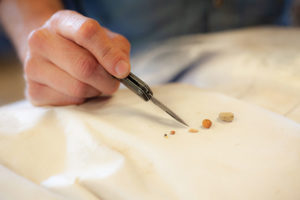
Cover crops
One of the research studies in which NicNut participated included helping researchers determine that summer cash crop water budgets do not need to be amended to winter cover crops, “which was an amazing statement at the time because no one had known this until this point,” said Rory Crowley, director of habitat programs at Project Apis m.
Like all farms, NicNut had its on-farm challenges and suffered from sheet flooding, which resulted in annual soil erosion. Rory realized that the easiest way to address the farm’s soil and pollinator problems was to implement a cover cropping program. That year, the daikons were large and the cover crop towered over him.
Also, there was no erosion.
“It was amazing,” he said.
Both Cassi and Rory have advanced degrees with research backgrounds. This allowed the couple to continue their involvement in research activities — to “scratch that research itch” — while simultaneously improving the quality of both soil and yield in the orchard.
“It’s an inroad and the backbone to climate-smart practices,” said Rory about cover crops. “It really gives you an understanding, and it does a lot of things for your soil, your bees, biodiversity, all of these things. You just have to plant it once to experience it, and that’s when you start to think about things differently.”
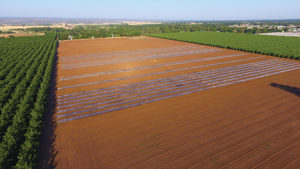
Biosolarization
Part of “thinking differently” is exploring unique methods to improve soil health, particularly after removing an orchard. When fields are fumigated for an orchard replant, methyl bromide or other powerful chemical fumigants are used to sterilize the soil, which indiscriminately kills beneficial microbiology.
Rory was a participant in the Almond Leadership Program through the Almond Board of California, and as part of his tenure with the program he dealt with almond hull and shell waste and residue. Aside from selling the byproducts to the dairy industry, what else was possible?
The team at NicNut partnered with Christopher Simmons and the Simmons Lab at University of California, Davis, to pilot a small biosolarization project after the removal of an old walnut orchard. Old almond hulls and shells were ground in a large tub grinder, and 6,000 pounds of this mix was then placed in a tree row where the future trees would be planted. It was then covered with a large, transparent plastic tarp to promote soil heating and had a drip line beneath it to create an anaerobic environment, thus activating the pile.
This process is similar to solarization in that it involves solar heat, but biosolarization includes microbial activity that can ferment the sugars in almond hulls to produce acetic acid and other biopesticidal chemical compounds, said Rory, which is effective against pathogenic nematodes and other pathogens. It reaches targeted pests without destroying beneficial activity.
“Not only that, but it adds 1.25% organic matter to the ground,” said Rory. “One percent of organic matter is incredible, so to go above that — it’s never been done before in California at that scale.”
While there are increased levels of nutrients in the soil, treated trees were still outpaced in growth by the controls for the first two years. In year three, however, the trees experienced accelerated growth, the data started to move in the opposite direction, and the treated rows quickly caught up and outpaced the controls.
Research is ongoing as yields are being quantified on treated and control rows, using satellite and airplane imagery, boots on the ground, and a university research team.
This has been a five-year project and is still under research. The farm had treated rows and control rows, and “I wish we had done the whole orchard,” said Rory, “it was that good.”
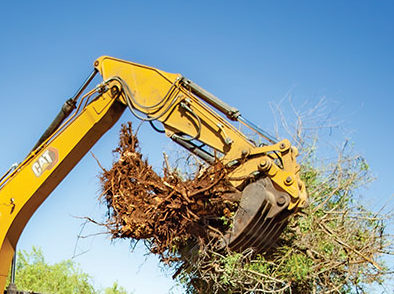
WOR
NicNut is also a recipient of a California Department of Food and Agriculture grant for whole orchard recycling (WOR), and has used it to remove over 50 acres of almonds that suffered due to oak root fungus, type of armillaria that shows up in almond trees planted in ground that had oak trees many generations ago, prior to modern cultivation.
WOR grants have been a big help to Central Valley tree nut farmers who need to remove orchards, especially those without the option of burning.
“Taking out an orchard is already an extremely cumbersome process financially,” said Cassi. “That ROI issue is constantly on growers’ minds.”
Following the global pandemic and record inflation, many grant schedules quickly become outdated. But the Crowleys and NicNut are pushing ahead with their on-farm research with WOR.
“Imagine for a second: 21 years of atmospheric carbon has been stored into these trees. It would otherwise be burned in a cogeneration plant or open-air burned, and it would go right back up [into the atmosphere],” said Rory. “Right here, we grind them up, and we put them right back down in the ground. Twenty-one years of atmospheric carbon. This is agroforestry at its best.”
Climate-smart story
“Consumers, both B2B and B2C, want the story — the pollination story, the soil health story, the carbon story. We are going to carbon neutrality and, hopefully, carbon negative by 2030. That’s how we want to see our farm moving in that direction,” said Rory.
With a push from consumer demand, and a forced hand due to global environmental changes, it’s inevitable that growers will face challenges in their conversions to climate-smart practices. Sometimes the biggest challenge is simply an objection to spending additional money on an unknown outcome.
“And it’s not just that we weren’t sure what the money was going to do,” said George, “but also the uncertainty of the markets.”
George has noted the rather dramatic evolution of the 30-plus years that he’s been removing and replanting orchards, and “this represents probably the single, biggest step in that regenerative, climate- smart process of putting that back in the soil,” he said.
Grants for California growers help cover the costs of orchard removal. Photo: Matt Hannon









